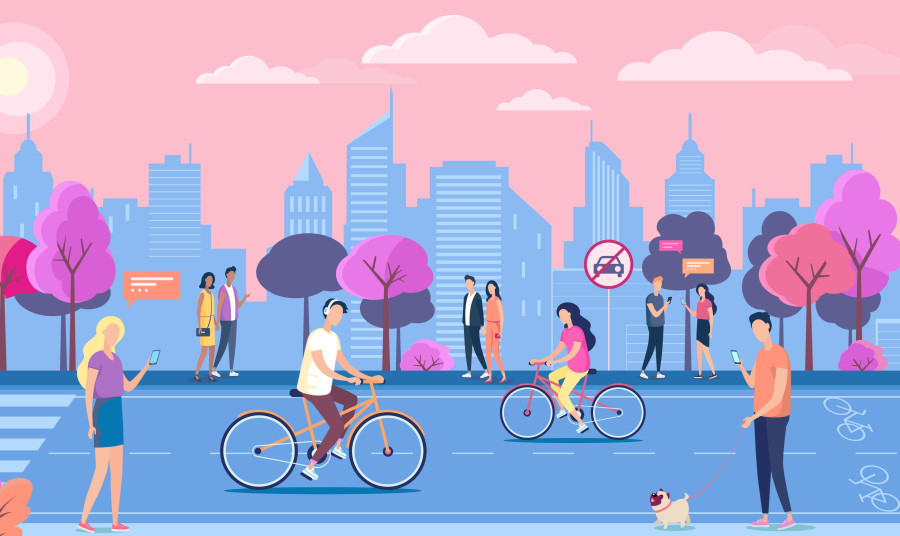Columns
Seeking affordable mobility
This is a great time to get people excited about walking and cycling if we can seize the opportunity.
Shubha Adhikari
If I conducted a survey today asking people in Kathmandu Valley if they have walked somewhere in the last couple of weeks, I am certain that almost everyone would respond affirmatively. All of us are pedestrians at some time or other. If I ask them if they used public transportation in the last 15 days, the majority will still say yes. But if I ask them if they used private vehicles, cars, in particular, only a few will say yes. Yet, when we build roads and streets, the emphasis is on motorcars and not on pedestrians or public transportation. Sidewalks are afterthoughts, bus stops and pick up and drop off locations for public transit services are not even a consideration, and pedestrian safety measures are often nonexistent.
A study done by the Kathmandu Valley Development Authority in 2017 showed that more than 40 percent of the trips made in Kathmandu Valley were on foot. About 28 percent were on public transportation, and about 1.5 percent were on bicycles. Only 4.2 percent of the trips were made in cars. Walking and cycling are the most affordable forms of mobility. But when an investment is made in a roadway designed exclusively for motor vehicles, private vehicles and their users—who account for a small percentage of the population—benefit the most. Pedestrians are likely to benefit the least from these investments. But they bear a disproportionate share of the burden of reduced safety, increased air and water pollution, noise and flood risks.
Wide roads no solution
Expanding roads is often seen as the obvious and the only solution to alleviating recurring congestion. Contrary to common understanding, expanding roadways without managing demand is never a solution. It will not only bring more vehicles, more pollution and more destruction to natural, historic and cultural resources, and it will never be able to alleviate congestion as intended. Moreover, there is a cost to operating and maintaining these roadways that would eat up significant financial resources in the future and become a burden to future generations. Instead, the focus should be on reducing the demand for motor vehicles and roadways. There are many ways to reduce and manage demand. Expanding roadways or adding lanes is certainly not one of them.
Demand can be reduced by making goods and services people need available in their own community, and by providing a variety of mobility options to choose from to suit their needs. If people can live near where they work, it will eliminate long daily commutes. Transportation agencies can manage demand by promoting and supporting alternative modes of transportation. They can lessen the demand for roadways and reliance on motor vehicles by developing safe and connected sidewalks and bikeways. Encouraging walking and cycling can help significantly reduce impervious surfaces and preserve green spaces.
Every year, a large chunk of the country’s money is spent on purchasing motor vehicles, fuel, maintenance parts and technical services. If we can popularise cycling for short distances and daily commutes and travel within urban areas, the reliance on foreign fuel and goods can somewhat be reduced. Households can spend less on transportation and can thus spend more on housing, healthcare and education.
In 2018, eight out of every 10 registered motorised vehicles on the roads in the valley were motorbikes, as per the Department of Transportation Management. That figure has most likely increased in the last few years. In spite of greater accident and fatality rates, motorcycles are increasingly becoming popular because of their affordability, size, ability to manoeuvre through narrow passageways and ease of parking where space is scarce. Even with the same basic qualities, bicycles are not that popular. Motorbikes don't offer any more protection from rain, wind, sun and accidental injuries than a bicycle. The only advantage a motorbike perhaps has is the speed. But in reality, with traffic congestion and road conditions, motorcycles don’t often reach their optimal speed. A study published in the Atmospheric Environment Journal notes that the average speed of vehicles in Kathmandu Valley ranged from 6 to 12 kilometres per hour.
Whenever I bring up the subject of bicycles, I am often asked whether they are realistic alternatives to motor vehicles. I am not suggesting that bicycles will replace every other mode of transportation. Of course, we will need other modes for long haul travel and freight. But bicycles can certainly reduce the use of motorbikes and cars in urban areas. According to the Kathmandu Valley Development Authority, the average trip length in Kathmandu is 5 kilometres for motorcycles and 5.4 kilometres for cars. Even taking the topography into consideration, these distances are easily within the range of bicycles if proper infrastructure existed. Mechanical bicycles might have some difficulty with hilly terrain, but electric bicycles would easily serve the need.
Kathmandu must build an efficient and reliable public transportation network to survive and thrive. But in the meantime, we should not ignore low hanging fruits like bike networks that have tremendous benefits at a much lower cost. We can start by prioritising the inner city for non-motorised vehicles and walking. Instead of expanding roadways along major rivers like the Bagmati and the Dhobikhola—which is contributing to flooding by narrowing their natural width—it would be much more sensible to build narrower bikeways with a pervious surface that would be able to handle occasional river swell during the rainy season.
Making cycling cool
Owning a vehicle is often associated with prestige and status in Nepali society. That might be changing with the younger generation being more conscious of the environment and social equity. This is a great time to get people excited about walking and cycling if we can seize the opportunity. Domestic and international events focused on cycling might help make it "cool".
Besides Kathmandu Valley, all these things are true for any other growing city in Nepal. Early investment in alternative transportation is necessary for an environmentally sustainable, economically sound and socially equitable transportation system. With the right mix of infrastructure policy, education and awareness, investments in bicycle and pedestrian facilities will pay back handsomely in the long term. As the newly formed provinces are establishing their capitals, it’s not too early to strategise about sustainable and equitable transportation, which is the backbone of development, and invest in alternative transportation.




 14.83°C Kathmandu
14.83°C Kathmandu















